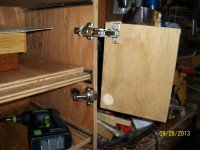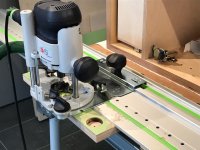Kodi Crescent
Member
- Joined
- Aug 6, 2010
- Messages
- 791
I've never built cabinets with drawers before, so I'd appreciate it if others with experience can check my logic before I begin plowing holes in my workpieces. My question is about using the Festool LR-32 with Blum Tandem/Solo drawer runners.
The cabinets will have full overlay doors with the tops and bottoms dadoed flush into the gable sides. The gables are full 32 mm increments in height for the LR-32 stops.
If I'm reading the Blum Process 32 plans correctly, all the Blum base cabinet plans start the c-t-c system holes at 46.5 mm and 78.5 mm from the bottom edge of the gables. (37 mm c-t-c in from the gable front edge, and 93 mm c-t-c from the rear edge to match runner mounting hole patterns). Holes are spaced at 32 mm increments where necessary for shelving and hardware installation.
If I'm measuring my LR-32 hole placement correctly (32 and 9.5 showing on rail underside, 9.5 against workpiece), my c-t-c system holes start at 48 mm and 80 mm from the bottom edge of the gable, a shift of 1.5 mm upwards from the Blum Process 32 plans.
So here's my logic -
When using the Tandem/Solo hardware, the +1.5 mm difference between the Blum Process 32 system holes and the LR-32 holes makes very little to no practical difference during the build, other than to shift drawer divider placement and drawer faces by 1.5 mm from the Blum plans.
Drawer divider placement adjusts +1.5 mm from the Blum Plan dimensions; bottom and top-drawer face heights adjust by +1.5 mm and -1.5 mm respectively. Drawer slides mount in the top row of mounting holes, except for the bottom drawer, which mounts in the lower row of holes.
Is this logic correct?
Thanks!
The cabinets will have full overlay doors with the tops and bottoms dadoed flush into the gable sides. The gables are full 32 mm increments in height for the LR-32 stops.
If I'm reading the Blum Process 32 plans correctly, all the Blum base cabinet plans start the c-t-c system holes at 46.5 mm and 78.5 mm from the bottom edge of the gables. (37 mm c-t-c in from the gable front edge, and 93 mm c-t-c from the rear edge to match runner mounting hole patterns). Holes are spaced at 32 mm increments where necessary for shelving and hardware installation.
If I'm measuring my LR-32 hole placement correctly (32 and 9.5 showing on rail underside, 9.5 against workpiece), my c-t-c system holes start at 48 mm and 80 mm from the bottom edge of the gable, a shift of 1.5 mm upwards from the Blum Process 32 plans.
So here's my logic -
When using the Tandem/Solo hardware, the +1.5 mm difference between the Blum Process 32 system holes and the LR-32 holes makes very little to no practical difference during the build, other than to shift drawer divider placement and drawer faces by 1.5 mm from the Blum plans.
Drawer divider placement adjusts +1.5 mm from the Blum Plan dimensions; bottom and top-drawer face heights adjust by +1.5 mm and -1.5 mm respectively. Drawer slides mount in the top row of mounting holes, except for the bottom drawer, which mounts in the lower row of holes.
Is this logic correct?
Thanks!


